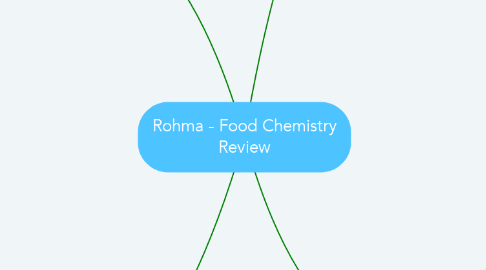
1. Carbohydrates
1.1. C6H12O6
1.2. Monosaccharides - 1xC6H12O6 Glucose Galactose Fructose Soluble
1.3. Disaccharide - 2 x C6H12O6 Soluble
1.4. Polysaccharide - more than 2 x C6H12O6 Not dissolved in water 1. Starch: a. Amylose - straight chained b. Amylopectin - highly branched 2. Cellulose - structural material in plants, we lack cellulase, cannot digest 3. Glycogen - energy storage in humans
2. Digestion: Mouth > Stomach > Small Intestine > Large Intestine
2.1. Mouth: Salivary Enzymes Chewing increases surface area
2.2. Carbohydrates --> Monosaccharides --> Polysaccharide (Glycogen) Proteins --> Amino acids --> proteins Triglycerides --> Glycerol + Fatty Acids --> Triglycerides
2.3. Enzymes: Biological catalysts that lower the activation energy of metabolic reactions to speed up chemical reactions in cells, very specific Different to inorganic
2.3.1. Lock & Key Enzyme
2.3.2. Enzyme Activity: Temperature - Increase in temperature, past it's optimal temperature - denatures, irreversible process Decrease temperature, slow down the rate of reaction, inactive pH: Optimal pH 1. Zwitterions may form and have a positive/negative charge 2. Disrupts ionic interactions between R-groups Changes in pH - changes to the active site - enzyme activity decrease Drastic pH change - permanent change in protein Concentration of Substrate/Enzyme
2.3.3. Denaturation: Kinetic Energy - quaternary and tertiary structure to break and change, enzyme loses its activity due to loss of 3D structure
2.4. Carbohydrates Digestion:
2.4.1. 1. Carbohydrates is broken down in the saliva by amylase 2. Disaccharide is broken down by maltase in the small intestine 3. Monosaccharide a. Used for energy production b. Reassembled to make glycogen
2.4.2. Lactose: Lactase to break down, disaccharide (glucose + galactose)
2.5. Triglyceride Digestion:
2.5.1. Non-polar they are not soluble in water Emulsification
2.5.2. 1. Fat -(bile)-> Emulsification (tiny droplets of fat) 2. Triglycerides are catalysed lipase to undergo hydrolysis into glycerol + fatty acid 3. Absorbed into blood stream --> triglycerides for our own use a. Energy Produce b. Adipose tissue c. Converted into other compounds
2.5.3. Rancidity: fat goes bad
3. Proteins
3.1. Monomer: Amino acids Polymer: Polypeptide
3.1.1. 2 Amino Acid
3.1.1.1. Zwitterions: Act as both an acid and a base Amino acid in acidic solution: Amino acid acts as a base, accepts protons -NH3+ cation Amino acid in a basic solution: Amino acid acts as an acid, loses hydrogen from carboxylic acid, donates a proton -COO- anion
3.1.1.2. Essential vs. Non-Essential Amino Acids: Essential - Amino acids must be eaten in diet Non-Essential - Synthesised by the body
3.1.2. How are proteins are formed? Condensation Polymerisation, Water Breakdown proteins? Hydrolysis Protein bond: Amide bond / Peptide Bond
3.1.2.1. Dipeptide - Two Amino Acids Two Isomers are possible? 1. NH2 + COOH 2. COOH + NH2
3.1.3. Protein Structure:
3.1.3.1. Primary: Sequence of amino acids - amide bonds
3.1.3.2. Secondary: Hydrogen bonds between the amide bonds of amino acids, between N-H & C=O 1. Alpha Helix: Coil - hydrogen bonds with every fourth amino acid 2. Beta Pleated Sheets: Polypeptide chains line up to each other
3.1.3.3. Tertiary: The interactions between the R-group/Variable group of the amino acids Overall 3D functional shape 1. Hydrogen bonds - R-Groups (-OH, C=O, NH2) 2. Dipole-Dipole bond - polar R groups 3. Ionic - -COOH & NH2 4. Covalent Cross Links - S - S 5. Dispersion Forces - Non-polar groups, polar groups
3.1.3.4. Quaternary: Interactions between two or more polypeptide chains
3.1.4. Globular vs. Fibrous Globular - soluble Fibrous - non-soluble
4. Lipids
4.1. Non-polar triglycerides with the glycerol backbone
4.1.1. How are triglycerides are made? 3 Fatty Acids + Glycerol --> Triglyceride + 3H2O Condensation Polymerisation - water is produced
4.2. Fats vs. Oils: Fats - Solid (animal sources - saturated) Oils - Liquid (plant sources - unsaturated)
4.2.1. Saturated - No Carbon-carbon double bonds Unsaturated - One or more carbon-carbon double bonds
4.2.1.1. Melting Points: 1. Saturation - presence of carbon-carbon double bonds C=C cause kinks in the chain, hence the molecules are not packed tightly together and hence they are held further apart, weaker intermolecular forces (dispersion forces), hence less energy is required to melt them, lower melting points 2. How long the carbon chain length? The longer the carbon chain, the higher the melting point due to increase in intermolecular forces (dispersion forces), more energy is required to melt them, higher melting points
4.2.1.2. Iodine Test - to determine how saturated a fatty acid is

